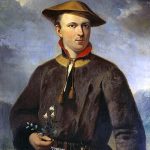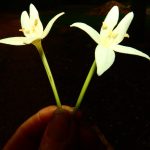TREE LIFE 537
MAY 2025
PLANNED EVENTS:- MAY
Since inclement weather or other issues may vary our plans, WhatsApp Tony Alegria on 0772 438 697 to join our WhatsApp group for last minute updates.
Saturday 3rd May 2025:- visit to the National Botanic Gardens. Meet at 8.30 in the main car park and join us for a morning looking at trees that catch our interest.
Sunday 11th May 2025:- Main meeting, AGM & social. The 75th A.G.M. will be held at the home of Bill and Fiona at Val d’Or on Sunday 11th May 2025 at 9.30 a.m. As well as the AGM, we will have a full fun day of looking at trees and socialising. Frances Morris has very kindly offered to cater for the lunch which will be paid for by the Tree Society of Zimbabwe but please bring a contribution for morning tea.
For seating and catering purposes we need to know who will be attending.
Please advise Bill Clarke, WhatsApp 0772252720, or email wrc@mweb.co.zw, if you will be attending or if you wish to give your apologies.
In due course, directions will be sent to those members attending.
For a detailed programme, see the end of this issue of Tree Life.
NOTE: For the purposes of our newsletter, all species of acacia have been given their specific genus name, Vachellia or Senegalia.
WANTED
We are often asked by folk who have a genuine use for a copy of “A New Zimbabwean Botanical Check List of English and African Plant Names” (The vernacular names book) by L J Mullin. These were originally given to members at no cost, but if you find you are not using yours, please hand it over to Tony or one of the committee.
REPORTS FROM PREVIOUS OUTINGS
Saturday 5th April 2025:- National Botanic Garden Outing
By Linda Hyde with assistance from Tony Alegria, & Mark Hyde, photos by Jim Dryburgh
A lovely warm autumn day and 14 members of the society met to hunt in the gardens for trees with bipinnate leaves. With this number of members, the groupings became fluid as we searched for these leaves.
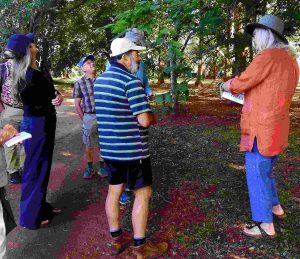

Besides the authors and photographer of this article it was lovely to see Charles Crawshaw, Dawn Siemers, Dido deSwart, Firle Davies, Francis and Peter Morris Jenny Milne, Jono Wood, Paul Grobler, Stuart Wood and Sue Fawcett.
Last month Tony took us through bipinnate acacias (vachellia and senegalia), so the main purpose of this month’s walk was to look at trees with bipinnate leaves which were not acacias.
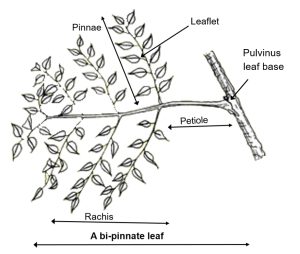
Bi-pinnate leaf structure
A recap of leaves, pinnae and leaflets followed, this illustration with thanks to the website “Weeds of Australia”, showing terms such as:
pulvinus leaf base, the swelling used by the leaf to angle it depending on light, temperature and touch,
rachis, the main axis of the leaf to which leaflets are attached, not to be confused with the
petiole, the bit before the pinnae are attached.
Later on Mark added the following note:
The pinnae and leaflets of bipinnate leaves can be opposite or alternate (above is opposite pinnae and alternate leaflets).
In general:-
opposite pinnae and leaflets are found in acacia, albizia, Xylia and Dichrostachys; while
opposite pinnae and alternate leaflets occur in Burkea africana (the wild syringa), Amblygonocarpus (the Scotsman’s rattle), Erythrophleum africanum and E. suaveolens (both known as ordeal trees) and Tara spinosa (opposite or subopposite).
Other key features are the number of pairs of pinnae, the number of leaflets per pinna, whether they are alternate or opposite, then the shape and texture of the leaflet.
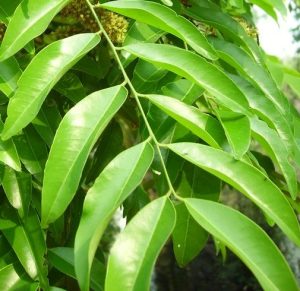
Erythrophleum suaveolens
Starting with the ordeal trees, Erythrophleum africanum and E. suaveolens, so called because the bark was traditionally used to create a toxic concoction used in trials by ordeal. If the concoction was strong, the suspect would vomit, thereby getting rid of the poison and would live and be considered innocent. However, if the brew was so weak the suspect retained it, they were deemed guilty and often died. The differences in the leaves and leaflets is huge with africanum having much smaller, more rounded hairier leaflets, than suaveolens.
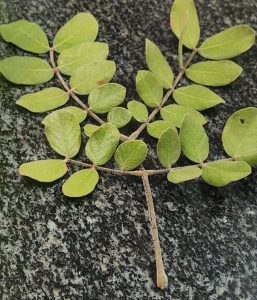
Albizia versicolor
On the Albizia versicolor we looked at the hairy leaves and rachis as well as the swelling at the base of the leaf, the pulvinus. The word pulvinus is Latin for a pillow, however its purpose is to swell or shrink, causing the leaf to move in response to environmental stimuli like light and gravity.
The Leucaena leucocephala or river tamarind with the large number of leaflets took us to South America where many of the trees seen seemed to originate.
However the fern-like leaves of the Moringa oleifera or horse-radish tree took us to the Indian subcontinent. With its distinctive smell of Indian cuisine it has become a popular brew in the form “Moringa tea”, a caffeine-free herbal beverage known for its nutrient-rich profile and potential health benefits.
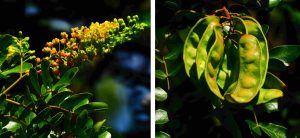
Tara spinosa: flower spike and fruits
The spectacular flowers and fruits of the Tara spinosa returned us to the South American continent, this time to the colder area of Peru.
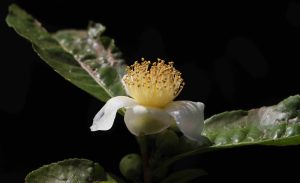
Camellia sinensis
At home, the Entada abyssinica with the leaflets opposite gave us a special display of its ladder like dehiscent fruit and the Xylia torreana or hairy sand ash with only 1 pair of pinnae and each pinna with 3-6 pairs of large leaflets.
Of course, we did not simply limit our observations to trees with bipinnate leaves. The perfect flowers of the tea bushes Camellia sinensis were much admired and the distinctive hooks of Artabotrys brachypetalus were noteworthy.
The crushed leaves of the Cinnamomum camphora drew our attention where the beautifully rounded black berry was admired but the peculiar structures on the growing tip caused much confusion. On dissection the onion-like structure appeared to house the beginnings of a flower with petals.

Cinnamomum camphora
flower and fruit L; old flower stalk and “buds” C; dissected bud R
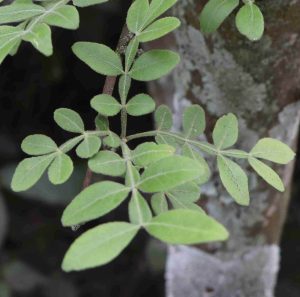
Citropsis daweana
The distinctive winged rachis of Citropsis daweana caught our eye with its opposite leaflets increasing in size towards the end of the leaf and covered in grey hairs.
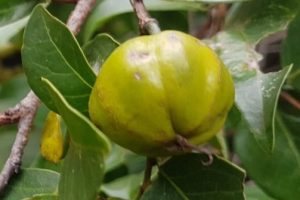
Sclerocroton integerrimus
Also distinctive was the 6-lobed fruit of the Sclerocroton integerrimus or tallow tree. We discussed the reason behind this common name. I took one of the fruit home to see if I could create a candle; needless to say I did not succeed and the internet only mentions that they have been used to make black ink and for tanning, not as substitute candles!
The Tree Outing to Don Lapham’s Garden – Easter Sunday, 20th April 2025
By Tony Alegria with photos by Jim Dryburgh
Present on a cool overcast Sunday were the ladies: Ann Sinclair, Dawn Siemers, Linda Hyde, Marina Mason, Teig Howson, Carrie Lapham and her guest Marlies Gruber. together with the men: Ian Riddell, Jim Dryburgh, Mark Hyde, Don Lapham and his neighbour Art Cooper and myself.
Under a few Croton megalocarpus. Kenya crotons, we began by having tea supplied by Don and Easter eats (savoury and sweet) supplied by Linda – thanks ever so much Don and Linda, marshmallow eggs with yellow in the centre are great!
We began botanising outside the gate where there was a concrete bench and table under a rather large Senegalia (Acacia) polyacantha. Visible from this vantage point, just inside the property wall, were a number of Msasas and displaying the “stretch marks” which I always look out for was a Lannea discolor (also known as the “Live long” tree). This tree loses its leaves for a long time over the winter period and thus breathes through the corky lenticels that make up the stretch marks!
There was also a Pride-of-India tree in this section – in fact we saw a number of these Lagerstroemia indica trees in the garden.
Within the turning circle for vehicles going into and out of the garage there is a tall Vachellia (Acacia) abyssinica or Nyanga flat-top, with its twiggy appearance and leaves that are three times longer than wide. This tree is one of the few acacias that can have very papery bark especially when young.

Queensland Umbrella tree, Heptapleurum actinophyllum (Schefflera actinophylla)
The whole property slopes down to the road and has a number of thatched buildings, next to the wall we were then stumped for the identity of five chest high bushes!
Further up the slope we looked at a Schefflera actinophylla. now known as (Heptapleurum actinophyllum) or the “Umbrella tree” which didn’t look typical as the leaves were large with very long petioles. Elsewhere there was another schefflera – Schefflera arboricola, the dwarf umbrella tree with much smaller leaves.
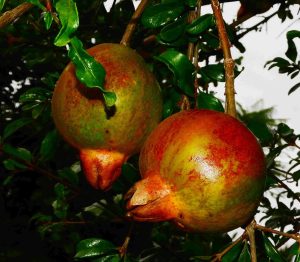
Big fruited pomegranate
Nearby was a Chinese guava tree – Psidium cattleianum, strawberry or cherry guava, with young fruit. There was also an unusual pomegranate tree in that it had a short single trunk whereas most of them have multiple trunks from the base. Also close by there was a multi-stemmed miniature of the pomegranate tree.
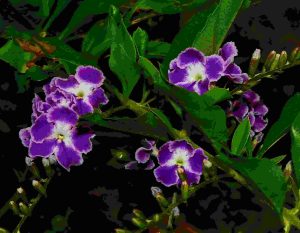
Duranta erecta
There were many Duranta erecta, forget-me-not or golden dewdrop trees, around the garden as well as Hamelia patens or fire-bush which attract many sunbirds to their flowers.
There was a medium sized Ziziphus mucronata. Buffalo thorn with not a single normal looking fruit on it. They had all been hit by a fungus which made them open up and look fluffy white!
There was a small Castanospermum australe, Moreton Bay chestnut or black bean tree with a couple of pods. Linda did something I can longer do without breaking something! She cracked the pod open with her teeth! Inside was one normal looking seed that looked like a chestnut – the other seed looked stunted!
This tree is native to the rainforests on the east coast of Australia. Nearby was another tree from Australia – the Hymenosporum flavum. Native frangipani which at this point in time didn’t have any of its yellow flowers. Here’s an interesting fact I found in Wikipedia.
“The very fragrant flowers are quite large, about 40 mm diameter with a floral tube up to 28 mm long. They are initially functionally male, and coloured white with lemon tinges. Over a period of about 5 days the stigma begins to develop and the stamens curl away. At the same time the colour deepens until the fully functioning female flower is golden yellow with red/purple track lines in the throat.”
Don, can you watch out for this? It would be interesting to know if this happens away from its natural habitat!
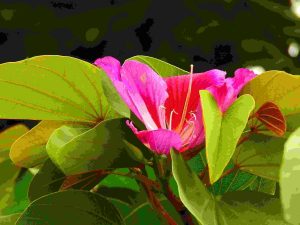
Bauhinia x blakeana
We came across a otherwise known as the Hong Kong Orchid Tree. This is a natural hybrid discovered in around 1880 on Hong Kong island. It may produce the odd pod but has sterile seeds so cannot be propagated by seed. It is grown from cuttings or plants obtained by air-layering. Since 1997 the flower appears on Hong Kong’s coat of arms, flag and coins. It appears that all the trees came from a single tree so in theory, they are all identical!
Some of the other trees we looked at that are not mentioned above were:
Persea americana, the avocado pear, also known as butter fruit or alligator pear;
Bolusanthus speciosus, the tree wisteria;
Kigelia africana or sausage tree;
Ficus microcarpa, the Chinese banyan or weeping fig;
Ficus pumila, the creeping fig or tickey creeper;
Ficus carica or common fig;
Homalanthus populifolius. the bleeding heart or Queensland poplar;
Lycianthes rantonnetii or blue potato bush.
After the botanising walk around the garden, we went back under the Kenya crotons to enjoy some more Easter fare! Many thanks to our hosts: Don and Carrie Lapham.
MORE ON THE BOTANY OF WILLOWMEAD LANE
By Mark Hyde
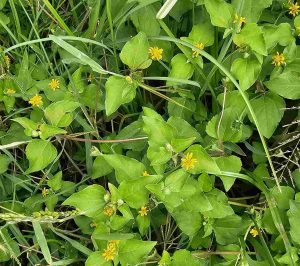
Calyptocarpus vialis, the
Straggler daisy
In my write-up of the garden trees of Willowmead Lane (Tree life: 536, April 2025), I mentioned that we had found “a small, yellow-flowered annual weed, still to be named but probably new to the city”.
The same small plant (actually a perennial) was found again in Don Lapham’s garden on 20 April. It has now been identified as Calyptocarpus vialis, the Straggler daisy. It is another American introduction which occurs naturally from SE USA, Central America to Venezuela.
It was first recorded for Zimbabwe by Bart Wursten, Petra Ballings and me in 2010 in Hwange National Park. A second sighting was at the Victoria Falls in 2022. Now it has turned up in Harare and it is quite likely spreading to other parts of Zimbabwe.
Further information about the species can be found online at https://www.zimbabweflora.co.zw/speciesdata/species.php?species_id=223180.
FOREST BATHING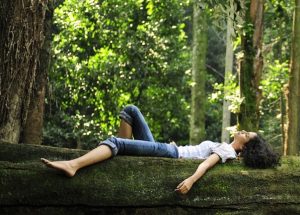
By Jan van Bel
The unusual association of these words must certainly attract some attention if you haven’t heard of it before.
“Forest bathing” is the literal translation from the Japanese “Shirin yoku”. It is now a recognised therapy and is part of the preventive health care system.
As humans have been evolving over millions of years as part of a holistic entity, our earth, it must be accepted that connections and harmony are found between everything earthly. During those millenniums people have learned to live with and in need of the proximity to plants and trees and during that time our five senses evolved and were stimulated by our surroundings.
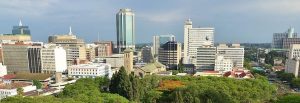
In a period of only a few hundred years people then started living in concrete mega-cities and high-rise buildings. Some need an hour’s drive to get to a forest or even a park (probably planted).
If that harmony and mutual dependency is disturbed in such a short time a lot of coping mechanisms must have been initiated (all inducing stress), but the human body will at least need a few thousand years to adapt to this new situation.
In our overstressed and competitive world, “forest bathing” is slowly becoming one of those wellness and mindfulness therapies used to repair or heal our minds and bodies. In Japan it is now a recognised therapy with proven benefits.
Walking through a forest works on all our 5 senses:
- Sound of rustling leaves and birds singing, wind howling. We all know that sound and music affects us. These days music is used in public places to work on the mood of people. A monotonous type of music (called “Musak”) is used in railway stations, shopping malls and restaurants, to work on people’s mood for relaxation. Some farmers use classical music to have their chickens produce more eggs!
- Scent is used in aroma therapy, ayurvedic medicine and herbalists use plant essences as a cure. All those natural perfumes from leaves and flowers have an effect on us, no matter how small or inconspicuous it may be. Or just the fresh clean air, which gives us comfort away from the oppressive toxic exhaust fumes from town or factory.
- Light is the primary natural source of vitamin D for humans. Sunlight playing through the canopy of the forest. It certainly has an effect, different from the stroboscope in a nightclub although colour-therapy is an old healing method, still in use. What an effect must flowers have on our bodies through our brains, not only joy and love! Plenty of fast-food restaurants are painted yellow because it stimulates the stomach.
- Touch with feet and hands and lips. Walking and being in contact with the soil (better still on bare feet), our electrical charge being regulated. Feeling the texture of leaves or bark. Compare it to the toys psychologists and therapists are using to influence anxiety with plush, squeezy and slippery objects that have to be handled .
- Taste all those berries and herbs, if not medicinal, then maybe taste.
The power of the forest is in all these senses.
It refreshes and rejuvenates us. It gives back energy and vitality. With all the wellness clinics being set up these days, it will not take long before this method of healing will be practiced on a commercial scale here in our country. Since the 1980’s it has become a well-known therapy in Japan. Also in the US and Canada, you can join in a session of forest bathing after paying a fee to the guide.
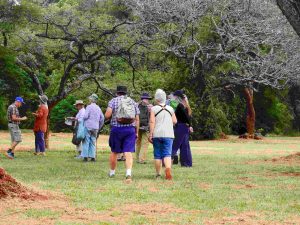
Closer to home we don’t have to go far and don’t have to pay to enjoy these benefits.
Some people even use our tree-walks for this purpose without being burdened by, not listening to or worried by all the botanical information that is given to us .
For others (including me) it still has its relaxing benefits, the overload of eagerly accepted information together with the physical workout of the walk and I feel well, tired and relaxed and sleep well.
POCKET FORESTS IN THE CITY OF BULAWAYO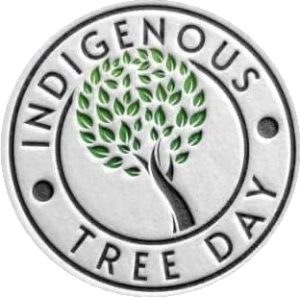
Source: The City of Bulawayo @CityofBulawayo
On 16th April, The City of Bulawayo launched its first “Indigenous Trees Pocket Forest” in the Centenary Park at a ceremony attended by His Worship the Mayor, Senator David Coltart, and Busi Malunga the Managing Director of Africa Tree Seeds Group as well as Several Councillors and other residents of the city.
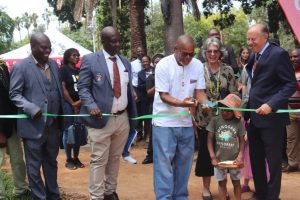
The Mayoress, Mrs Jennifer Coltart, who is the Patron of the Pocket Forest Initiative and the City’s Climate Ambassador was instrumental in the establishment of this initiative where 100 indigenous trees were planted, as part greening the City initiative.
Speaking during the launch of the pocket forest, Senator Coltart expressed concerns over disparities in trees coverage. He said the Council has a 2050 target to have planted trees in both western suburbs and eastern suburbs.
The City of Bulawayo has partnered with institutions such as Ernst and Young Zimbabwe who have pledged to educate youth on the importance of environmental stewardship and is committed to planting 5,000 trees annually with the establishment of “Pocket Forests” proposed across the City’s 29 wards. Indigenous trees have been selected for planting as they have medicinal and education benefits and are easy to manage as they are adaptive to the environment.
FROM OGDEN NASH TO THE WALRUS AND THE CARPENTER
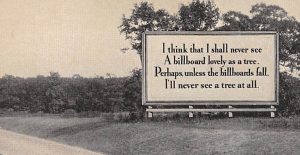
I think that I shall never see
A billboard lovely as a tree.
Perhaps unless the billboard fall,
I’ll never see a tree at all.
THE ANNUAL GENERAL MEETING OF THE TREE SOCIETY OF ZIMBABWE
(Please read notice of planned events at the start of the newsletter for further detail)
The 75th A.G.M. will be held on Sunday 11th May 2025 at 9.30 a.m.
Any proposals/resolutions and nominations for office bearers (and any volunteers to be on the Committee) should be forwarded by email to the Secretary, Teig Howson at: teig.howson@gmail.com by Wednesday 5th May if possible, although proposals and nominations will be accepted from the floor.
N.B. The minutes of the 74th A.G.M. held last year will be circulated again by email and will therefore be taken as read at this year’s A.G.M.
AGENDA:
- Notice convening the meeting.
- Apologies
- Matters Arising
- Chairman’s Report
- Treasurer’s Report
- Election of Office Bearers
- Any other business
However, as we have done in the past, we will be having the social on the same day, program below:
09:30 Coffee / Tea and Eats
10:30 AGM
11:00 Scavenger Hunt
12:00 Socializing and lunch
14:00 Fun Quiz
15:00 Coffee / Tea / Eats and socializing
This function is for members only, membership includes a spouse and children under the age of 16.
SOCIETY COMMITTEE AND CONTACTS
Chairman Tony Alegria tonyalegria47@gmail.com 0772 438 697
Vice Chairman Mark Hyde mahyde@gmail.com 0772 233 751
Honorary Treasurer Bill Clarke wrc@mweb.co.zw 0772 252 720
Secretary Teig Howson teig.howson@gmail.com 0772 256 364
Venue Organiser Ann Sinclair jimandannsincs@zol.co.zw 0772 433 125
Committee Member Jan van Bel jan_vanbel@yahoo.com 0772 440 287
Committee Member Sibusiso Malunga busimalunga@yahoo.com 0775 889 898
Tree Life Editor Linda Hyde Lmharwin@pentact.co.zw 0772 232 075
Tree Society Website https://treesociety.org.zw/
Tree Society Facebook https://www.facebook.com/groups/ztreesociety/
Flora of Zimbabwe: https://www.zimbabweflora.co.zw/
Flora of Tropical Africa: https://plants.jstor.org/collection/FLOTA


